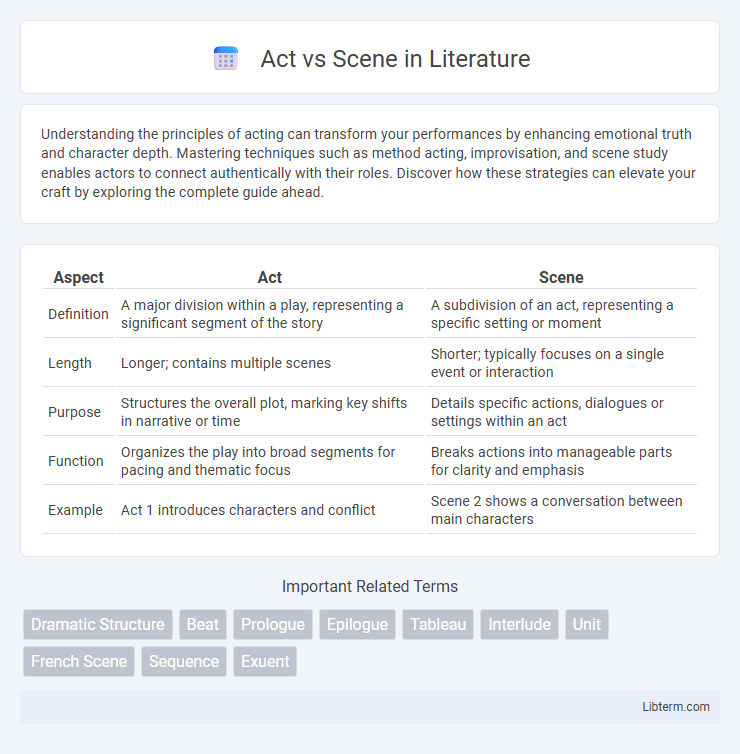Understanding the principles of acting can transform your performances by enhancing emotional truth and character depth. Mastering techniques such as method acting, improvisation, and scene study enables actors to connect authentically with their roles. Discover how these strategies can elevate your craft by exploring the complete guide ahead.
Table of Comparison
| Aspect | Act | Scene |
|---|---|---|
| Definition | A major division within a play, representing a significant segment of the story | A subdivision of an act, representing a specific setting or moment |
| Length | Longer; contains multiple scenes | Shorter; typically focuses on a single event or interaction |
| Purpose | Structures the overall plot, marking key shifts in narrative or time | Details specific actions, dialogues or settings within an act |
| Function | Organizes the play into broad segments for pacing and thematic focus | Breaks actions into manageable parts for clarity and emphasis |
| Example | Act 1 introduces characters and conflict | Scene 2 shows a conversation between main characters |
Understanding Acts and Scenes
Acts divide a play into major sections, establishing the overall structure and pacing of the narrative, while scenes break down acts into smaller units that focus on specific moments or interactions. Each act often represents a significant phase in the plot development, and scenes provide detailed context, character dialogue, and setting changes within that framework. Understanding how acts and scenes function helps in analyzing a play's progression, themes, and dramatic tension effectively.
Definition of an Act
An act is a major division within a play or theatrical performance that structures the storyline into distinct segments, each comprising multiple scenes. It serves as a key organizational unit in drama, marking shifts in time, location, or plot development. Typically, an act encapsulates a significant portion of the narrative, providing clear transitions and pacing for the audience.
Definition of a Scene
A scene is a subdivision of an act in a play, representing a specific moment or setting where characters interact without changes in time or location. It serves as a unit of dramatic action that drives the plot forward through dialogue and events confined to that singular environment. Unlike acts, which encompass broader segments of the narrative, scenes provide detailed focus on particular incidents within the storyline.
Purpose of Acts in Storytelling
Acts serve as major structural divisions in a play or screenplay, organizing the narrative into distinct segments that highlight key plot developments and shifts in time or setting. They guide the audience through the story's progression by establishing rising action, climax, and resolution, creating a coherent and impactful emotional journey. Each act functions as a self-contained unit that builds tension and deepens character arcs, ultimately enhancing the storytelling experience.
Role of Scenes Within Acts
Scenes function as the building blocks within acts, providing detailed segments that structure the narrative and pacing of a play. Each scene introduces specific settings, character interactions, and plot developments that contribute to the overall progression of the act. By dividing acts into scenes, playwrights create clear transitions and maintain audience engagement through focused storytelling moments.
Structural Differences: Act vs Scene
Acts serve as the primary divisions within a play, often marking major shifts in time, location, or plot development, while scenes are subdivisions within acts that indicate smaller changes in setting or action. Structural differences include acts being longer and more comprehensive units, sometimes encompassing multiple scenes with continuous or related narrative flow. This hierarchical organization allows for clear pacing and structural coherence, with acts framing the overall story arc and scenes providing detailed, moment-to-moment progression.
Common Examples in Literature and Theater
Acts and scenes are fundamental structural units in plays, with acts serving as major divisions that segment the narrative into broader parts, while scenes denote smaller segments within acts, marking changes in time or location. Shakespeare's "Hamlet" typically contains five acts, each divided into multiple scenes that reflect shifts in setting or character focus, illustrating this classical structure. Modern plays like Arthur Miller's "The Crucible" use fewer acts but multiple scenes to maintain a dynamic pace and highlight key moments within the broader act framework.
Practical Tips for Dividing Acts and Scenes
Dividing acts and scenes effectively requires understanding their distinct purposes: acts mark major story shifts or time lapses, while scenes focus on specific events or character interactions within those acts. Practical tips include using acts to structure the narrative arc, ensuring each act contains a clear beginning, middle, and end, and breaking scenes based on changes in location, time, or key character dynamics. Maintaining consistent pacing and logical transitions between acts and scenes enhances audience engagement and clarity.
Impact on Audience Experience
An act structures a play into larger, significant segments, setting the overall rhythm and pacing that shape the audience's emotional journey. Scenes break down acts into more detailed moments, allowing for shifts in setting, time, or character focus that keep viewers engaged and enhance narrative clarity. This dual layering of acts and scenes strategically controls tension and release, deepening audience immersion and understanding.
Act and Scene Formatting Guidelines
Acts are major divisions within a play, typically consisting of multiple scenes, and are formatted with centered, bold, or uppercase headings to clearly indicate the start of a new act. Scenes, which divide acts into smaller sections representing changes in time or location, are usually labeled with scene numbers or titles in italics or smaller bold font, aligned left or centered beneath the act heading. Proper act and scene formatting ensures clarity for actors and readers by visually distinguishing structural shifts and maintaining consistent hierarchy throughout the script.
Act Infographic

 libterm.com
libterm.com